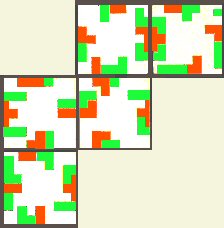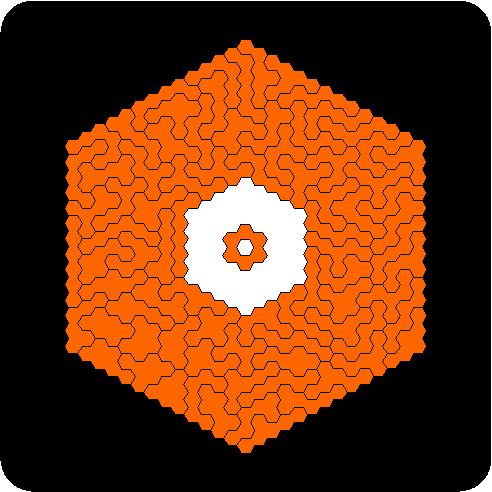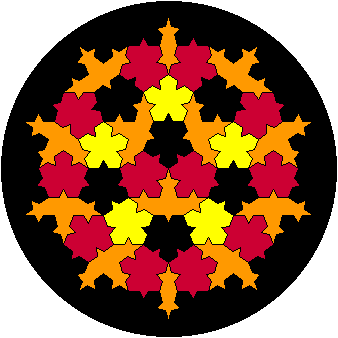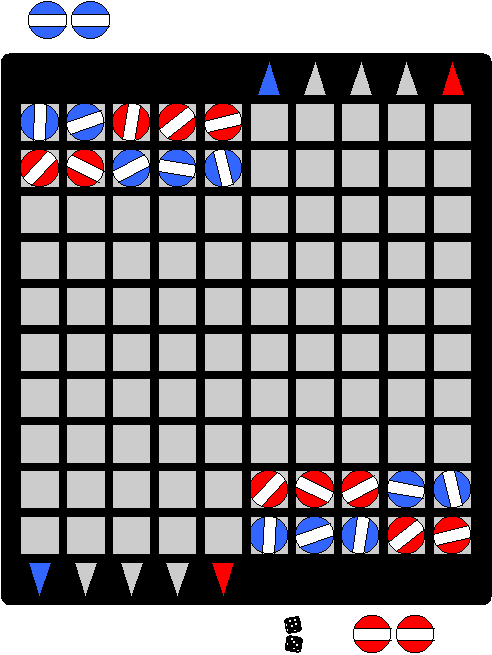 
In 1995 we had introduced a number of colorful tilings, some based on the golden ratio and some nice little polyform sets, building our product line into a great variety of styles and themes of both games and puzzles. We followed them in 1996 with the development of even fancier geometric sets that allowed many amazing patterns with more complex groups of pieces... ever closer to the genre dearest to our hearts: combinatorial tilings as gorgeous geometrics.
  Brace/EmbraceTM Brace/EmbraceTM
Brace was invented by Alan Kross-Vinson and fit our design ideals superbly, with its artistic grid, multiple games, non-violent themes, and potential even for puzzles. In its first form we styled it as a screen-printed canvas tapestry, with the classic Nine Men's Morris board on the back. Colors of canvas varied. Later we also crafted its deluxe wood version. In 1998, Brace won a place on Games Magazine's list of the 100 best games. We were devastated to learn that Alan passed away of cancer in 2008; he was only 47. His wonderful game lives on.
  Diamond RainbowTM Diamond RainbowTM
Created by our dear friend, Anneke Treep of The Netherlands, the 24 diamond-shaped tiles (made of two equilateral triangles joined) plus 6 single triangles have every combination of the 6 main rainbow colors and has been one of our most popular sets for 25 years. We make them from lasercut acrylic, hand-inlaid with great care. Join the tiles so colors meet their own shades or their neighbors in the spectrum. Wonderful patterns emerge as you rearrange the tiles, both in and outside the 8.5" tray. It makes endlessly many wonderful shapes and designs, beloved by all ages. And as an exception, we printed its booklet in full color for the most vibrant effect. Rainbows are forever.
  Fill-AgreeTM Fill-AgreeTM
Here is one of the 25-piece puzzles invented by Kate Jones for Kadon's 25th anniversary. The tiles are sizes 2 through 4 squares (the smaller members of the polyominoes family), each with two holes in all different positions, plus six single squares. They can create many interesting patterns in 2D and 3D, easy and difficult. Transparent colors give a sense of stained glass, a puzzle plus decorative art, where each size of piece gets its own color. The holes form solution challenges as well, with magic-square arrangements and special groupings. Hence the name, "Fill" and "Agree", plays on its visual effect, filigree.
  Fractured FivesTM Fractured FivesTM
In 1986, Kate was invited to an annual puzzle party hosted by the world's most eminent puzzle collector, Jerry Slocum, in his Beverly Hills home with a mere 20 guests. Kate decided to bring a small gift for each guest, based on the pentomino puzzle that had launched her company: Quintillions. So she designed a puzzle of five squares, made of cardboard, handcut and with the two sides glued on with rubber cement—with partial pentominoes on the edges of one side and images of rope segments on the other. Only 24 sets were made of this very first version of Fractured Fives. (See historical notes for 1986 for the rest of that story.)
Ten years later, for the second Gathering for Gardner in Atlanta in 1996, we supplied 100 sets of printed sheets for attendees to cut out for themselves, and a page of instructions. For the 25th anniversary of that event, in 2011, we finally gave Fractured Fives a well-deserved permanent place in our product line, embodied as two-sided, hand-finished, engraved wood blocks with hand-painted accents. But that's a story for another year.
  Hexnut IITM Hexnut IITM
Daring to go big, we produced this expanded set nine years after our original Hexnut (1987). Its 82 different pieces, each consisting of 6 hexagons, are sized to mix with its kin and form a splendid hexagon in their own grand tray. The clear center ring is a practical place to store the only hexahex with a hole, suggested by Robin King. The solution shown was found by Michael Keller. See also this fantastic collection of other grand hexahex designs by Nick Maeder from New Zealand. Nick's exquisite aesthetic visions have computer-assisted solutions to produce such feasts for the eye. Our Hexnut II booklet offers further challenges of various sizes plus some games. The set has a protective clear lid for display on its stand, an intriguing eyecatcher in any room. The lid also serves as a tray to hold pieces during solving efforts.
  Mini-Iamond RingTM Mini-Iamond RingTM
While we had introduced the Iamond Ring in 1987, Kate considered it much too difficult for most people and wanted an interim size to introduce these shapes more gently. This smaller group of just nine easy pieces—shapes made of 2, 3, 4 and 5 equilateral triangles joined—was just right. It fills the encircled pattern and forms a large variety of shapes outside the ring, too. For the toughest challenge, have no two of the same color share sides. A computer search by Bill Cutler proved only 2 solutions meet this condition—out of the 15,140 different ways to fill the circle! We had posed this question as a contest for the International Puzzle Party in 1997, and Bill's findings won the prize. Like most of our puzzles by now, we made the Mini-Iamond Ring of lasercut acrylic, a lively five-color mix in its 5.5" tray. It can entertain even six-year-olds. The one tricky step is to figure out how the 6 curvy border pieces need to fit.
  Mensa® logo puzzle Mensa® logo puzzle
Kate was attending Mensa's annual gathering and realized that the Mensa logo could be dissected into polyiamond pieces. Working out a suitable mix of all different tiles of sizes 4, 5, and 6 was an interesting challenge, and when Kate brought the set to the subsequent gathering, it stumped most of those smart folks, too. Only Mensa members are authorized to order this puzzle. If you're not a member but are intrigued by this idea, order our Iamond Ring instead; it contains all these shapes and more.
  PentaroseTM PentaroseTM
One of our most gorgeous art puzzles has a great pedigree: based on research by Sir Roger Penrose (recipient of Nobel Prize 2020 for work on black holes) into non-periodic tilings. The 36 fractal-edged pentagons and parts of stars were prototiles in Penrose's investigation, and with our input they became parts of a decagon with intriguingly many solutions. Fascinating to play with, even after 25 years. The 11" round tray makes a great frame for displaying it as a work of art.
  TransposeTM TransposeTM
Invented by Christopher Clark, we styled this elegantly inlaid 15.5x18" acrylic board with matching inlaid checkers as a contemporary companion to Chris' original traditional wood set we had introduced the year before. It plays 8 different games and a collection of solitaire puzzles. It won first place on Games Magazine's list of the best strategy games of 1996 and was on the Games 100 list again in 1997. Its slick look is offered in two opposite styles: black with gray, and gray with black. The board is beautiful enough to hang on a wall as modern art when not being played.
Prequels:
A Quarter-Century Retrospective (1980-2005)
1982-2007: The first wave of growth
1983-2008: The lesson of quality
1984-2009: Some things old, some things new
1985-2010: Guests and clones
1986-2011: Thinking big... and bigger
1987-2012: Growing three ways
1988-2013: Compounding complexity
1989-2014: Grand visions
1990-2015: Herculean heights
1991-2016: Happy marriages
1992-2017: Diamonds forever
1993-2018: Opulence in acrylic and wood
1994-2019: Angles, gold and gala
1995-2020: Tilting towards tilings
You are here:
1996-2021: Gorgeous geometrics
Sequels:
1997-2022: Big and little
1998-2023: Boards and beauties
1999-2024: Finding kindred spirits

|

